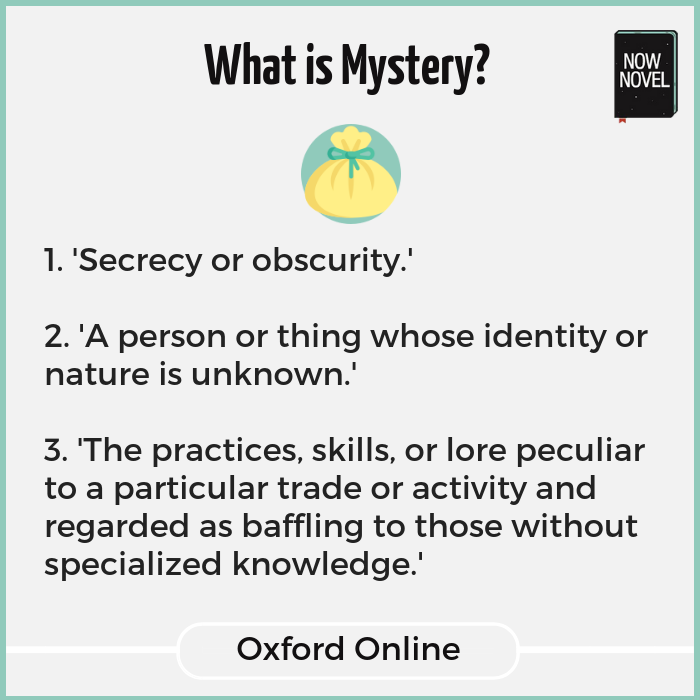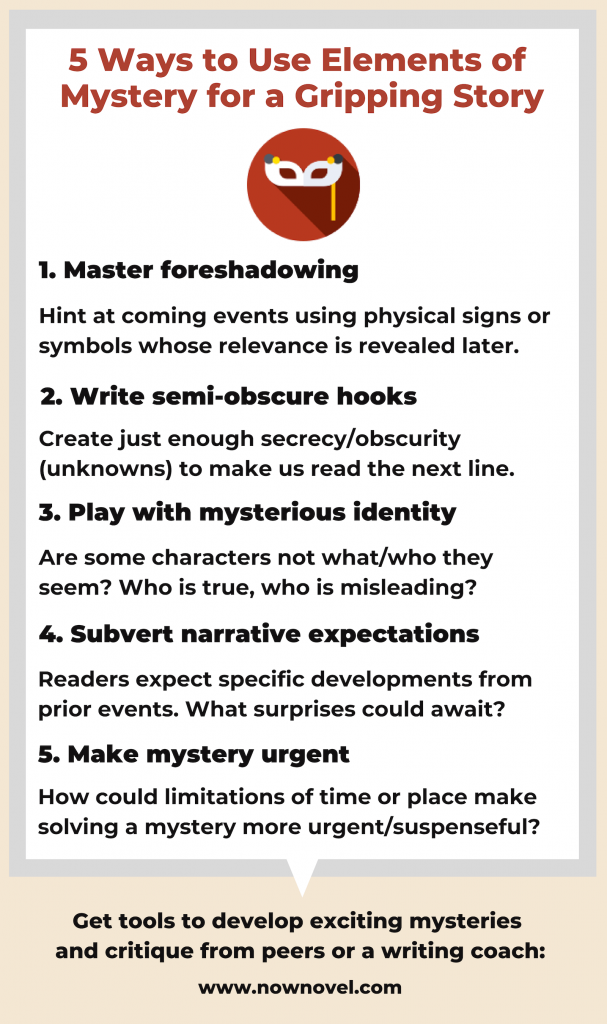Mystery elements are important in all genres, not only whodunits or suspense/thrillers. Here are 5 mystery elements and how you can use them to fill your stories with intrigue:
First, what is mystery?
When we talk about mystery as a literary device (rather than as a genre), mystery has multiple meanings. It can refer to:
‘Secrecy or obscurity’
‘A person or thing whose identity or nature is unknown’
‘The practices, skills, or lore peculiar to a particular trade or activity and regarded as baffling to those without specialized knowledge’ (e.g. ‘The mysteries of modern medicine’)
Oxford Dictionaries Online, definition of ‘mystery’
From the first two definitions, we see why mystery is important to all genres.
There is mystery in a romantic story, for example. When two potential lovers’ eyes meet across a room and they feel instant connection (like in Romeo and Juliet). This is a mystery of identity (the second definition).
When we read an incredible hook that makes us wonder what events a narrator is referring to, that’s mystery (the first definition).
So what can you do to create a sense of exciting unknowns approaching fuller revelation?

1. Master foreshadowing
‘Foreshadowing’ means a ‘warning or indication of (a future event)’ (Oxford Online).
In a story, this could also mean a hint of an event that happened in the past, but will be revealed in full later in the story. This is one of the gifts of storytelling – we can create future anticipation in readers for details about events that have already (in our fictional world) taken place. Time in storytelling is fluid.
Example of mysterious foreshadowing
In J.K. Rowling’s second novel in her beloved Harry Potter fantasy series, Harry Potter and the Chamber of Secrets (1998), the students repeatedly hear unnerving noises coming from the walls of Hogwarts magic school.
We only learn later [no spoilers!] the threatening source of these sounds, and its relevance to the broader struggle against the series’ main villain. The sounds in the walls thus create an ‘unknown identity or nature’ that fits our second definition of mystery.
How to master foreshadowing:
Practice leaving breadcrumb trails for your reader. In the famous fairy tale Hansel and Gretel, two siblings find a trail of crumbs in the woods that lead to a witch’s edible house (not knowing they’ll soon be on the menu!).
To foreshadow events and create mystery:
- Create physical or symbolic signs hinting at later revelations
The breadcrumbs in the woods are a physical hint (of the gingerbread house). The frightening sounds in the school’s walls in Chamber of Secrets are auditory details of foreshadowing. You can also use symbols that echo future events. For example, in Tolstoy’s Anna Karenina (1877) trains and train stations feature early in the story and play a central part in the story’s tragic climax and ending. - Foreshadow details of plot that are important to the story
Focus on foreshadowing mysteries and unknowns key to the story – the identity of a major or key secondary character, for example. Your reader won’t care what a character had for breakfast (though if they’re a cannibal, that might be something worth foreshadowing after all, as the reveal combines the mundane with the shocking or unexpected).
2. Write semi-obscure hooks
The first definition of mystery, ‘secrecy or obscurity’ is important when we think about hooks.
The ‘hook’ – the inticing sentence or paragraph that hints at where a scene, chapter or novel will lead – needs to have some of this secrecy and obscurity. There has to be an unknown whose revelation we, the readers, pursue.
Example of an effective, mysterious hook
Margaret Atwood opens her classic dystopian novel about a world where women are forced into assembly-line-like reproduction with this sentence:
We slept in what had once been the gymnasium.
Margaret Atwood, The Handmaid’s Tale, p. 13 (1985)
Even in this simple sentence, there is an intriguing hook. There is the second mystery definition: Identity is unknown (we don’t know who ‘we’ refers to). There is mystery of place, too. If the building ‘had once been the gymnasium’, what is it, now? Obscure points of reference (mysterious ‘we’, former gynamsium) supply multiple unknowns which in turn keep us reading the next line to solve the first, small mysteries.
Whether you’re writing dystopian fiction, romance, comedy, or any other genre, remember to lead with lines giving your reader at least a little obscurity, a reveal to pursue.
3. Play with mysterious identity
The plot of a classic murder mystery revolves around a mystery of identity – we wonder who killed the victim (or why). Yet mystery involving identity is a common fictional device in many genres:
- Who is the attractive stranger who saunters over to the protagonist in a dim bar? (romance)
- Who is the spy in a travelling band of heroes feeding the villain information secretly about the heroes’ exact whereabouts? (fantasy)
- Who out of multiple narrators giving subjective versions of events, is telling the truth? (literary fiction, e.g. As I Lay Dying by William Faulkner)
Characters can turn out to be not who they say they are. In a tragic romantic story, this might signal the end for a relationship built on lies and deceit. In a gripping, mysterious story, things aren’t always as they appear. People don’t necessarily have the intent or purpose they claim. [Find characters’ goals, secret or otherwise, in the ‘Characters’ section of our step-by-step outlining tool.]

4. Subvert narrative expectations
What we can imagine will or may happen (e.g the revelation of a murderer’s identity) is a crucial aspect of mystery in storytelling. Certain tropes or stock situations (‘The Approach of the Confident, Handsome Stranger’) might fill us with specific narrative expectations as readers.
For example, we might expect the cocky-looking stranger to say a smooth yet corny pick-up line.
We create mystery when the story departs from or subverts our reader’s narrative expectations.
Maybe the stranger in the bar opens his mouth to say something and has a debilitating stutter, for example.
Surprise is one of the great joys of mystery, and storytelling in general. Set up expectations and choose some to confound, frustrate or subvert. Approaching mystery this way can help you come up with interesting surprises, contradictions and unexpected plot twists.
5. Create suspense via urgent mysteries
In a mystery/thriller, urgency is a key element of what makes the mystery aspect gripping.
When the mystery of identity involves a person who’s done a terrible thing (and could easily strike again), there’s greater urgency for them to be caught. There are higher stakes riding on their arrest. Even if the killer is the POV narrator, a twisted anti-hero, there are high stakes involved in their staying mysterious to police and investigators. The situation is reversed – it’s urgent that the unsettling mystery (to other characters) remains one.
Examples of urgency in mystery
Whatever your genre, create suspense by making unknowns urgent. To give some genre-specific examples:
- Romance: A man on vacation wants to learn more about a mysterious woman he encounters briefly, but his flight home is the next day and they lose sight of each other before he can find out more
- Fantasy: A tyrant is seeking powerful artefacts which combined give devastating power, and has all except one whose whereabouts are unknown
- Comedy: A man in a stressful, embarrassing situation where he’s trying to stay hidden from others keeps getting distracting, loud phone calls from his wife reminding him to do trivial tasks
In each of the above examples, there is an urgent element to the mystery. The romance example gives time-dependant urgency. The man doesn’t have much time to make the connection he passionately wants.
The second urgent mystery creates suspense through high-stakes mystery of place. The protagonists would need to locate the artefacts before the villain (this is a key plot point in the final books of J.K. Rowling’s Harry Potter books).
In the third example, the mystery of how the man’s situation will resolve is made more urgent by the ticking time bomb that is the continued phone calls that could reveal his hiding place.
Join Now Novel and get tools to plot your story’s intrigues and constructive feedback from peers or a writing coach to make them compelling and effective.


4 replies on “5 mystery elements for intrigue in any genre”
I LOVE this. Every story MUST have a central mystery or it’s much ado about nothing.
Thanks, Elias. A good bit of intrigue always helps 🙂
Jordan, good theoretical framework that I can easily work with. Is it bad form to quickly move into action, or is it preferable to dedicate more time to describing the environment or the setting, texturing as it were, the canvas before launching urgency and intrigue?
Thanks for your question, David. I think with a mystery you can launch straight into the intrigue, with some description, and then layer in some of the setting as you go. You want to grab your readers right away, so I’d say move into the action, nail them, and then you can bring in some of the other parts.